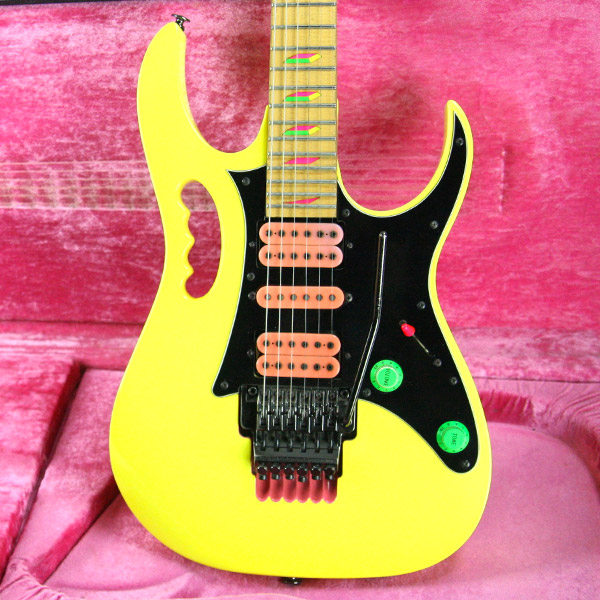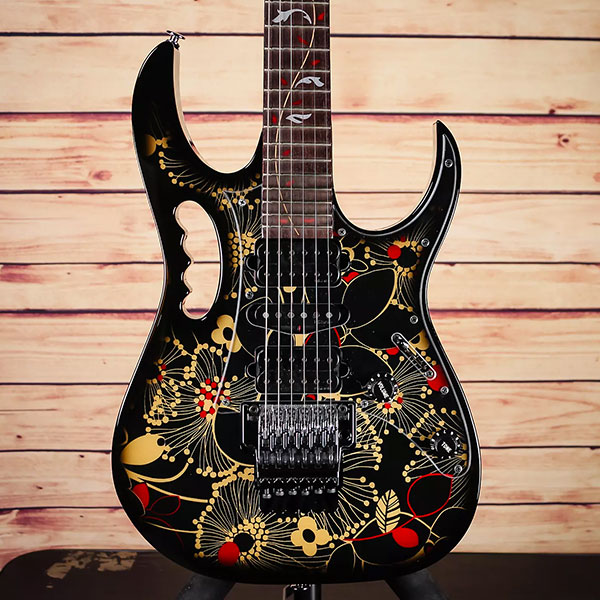In 1986, Joe Hoshino called a special meeting at Ibanez headquarters in Bensalem, Pennsylvania. Yoshiki "Joe" Hoshino was the boss at Hoshino USA, the American arm of Ibanez's Japanese parent company. The firm's top people joined him around the table, including president Mitsuaki "Mike" Shamada, and Rich Lasner and Bill Reim, who worked on designs, marketing, and pretty much anything else that needed doing.

Ibanez had problems. The guitar of the moment was the superstrat, with the Kramer brand well in the lead, assisted in no small measure by the endorsement from the superstar guitarist Eddie Van Halen. Ibanez was trying to join the superstrat club, without success. Business was poor, despite useful allegiances and signature models with Bob Weir, Steve Lukather, Allan Holdsworth, and others—each a fine guitarist, but not exactly a headline extreme rocker.
Joe declared that Ibanez must find its very own Eddie Van Halen. He put a question to the meeting. "Is there anybody out there who could work with us and represent the company and make a big impact on the market?" Everyone answered more or less in unison: "Well, yes—it has to be Steve Vai!"
Joe was impressed with the single-minded response and told them to go find this Steve Vai, talk with him, and do whatever they had to do to get him to work with Ibanez.
Steve Vai was a growing force, a guitarist with enviable musical and technical powers. He used vibrato dives, fast-picking flurries, tapping, noises, feedback, and a generous touch of showmanship. His break had come at the start of the '80s when, just 20 years old, he had joined Frank Zappa's elite touring band. His first solo album, Flex-Able, appeared in 1984, the same year he replaced Yngwie Malmsteen in Alcatrazz.
Toward the end of '85, he hit the big time, joining the ex-Van Halen vocalist David Lee Roth in a new supergroup alongside bassist Billy Sheehan and drummer Gregg Bissonette. His previous employer, Frank Zappa, said that Steve did everything that Eddie Van Halen ever dreamed of, and then some.
At Ibanez, meanwhile, the meeting broke up, and the mission to attract Steve Vai was underway.

Steve had learned an important lesson when he played with Frank Zappa. "I realized that I didn't have to be limited to the guitars that people are making and selling in stores," he recalls, adding that Frank would take a guitar—or any piece of gear—and squeeze it until it screamed for mercy. "Then he'd call the company and say, 'OK, but can you do this to it so I can make it do this, this, and this?' He'd do that with any kind of pedal, guitar, musical notation—anything. Frank was this fountain of creativity in all aspects. And it was always done with a joke, too."
Soon, Steve was poking and coaxing his own guitars. He'd joined Frank's band with a natural '76 Strat, a guitar he loved for its vibrato but hated for its sound. Now he wanted more frets than the Strat had, he wanted one of those new locking vibratos, and he wanted humbuckers. When he joined Alcatrazz in '84, he visited Grover Jackson in San Dimas, who gave him a Charvel shaped like a Strat but with humbuckers.
"For me it was like glory day," he tells me. "This is what I wanted—but there were still so many things about the guitar that I thought I wanted changed."
This Charvel Strat-style guitar, the "Green Meanie," became Steve's testbed and main working guitar. He added a single-coil in the middle of the two humbuckers, modding the five-way to give two in-betweens as well as three main settings of each pickup alone. He wanted the vibrato to pull up higher than a regular system. The problem was the body behind the bridge, he figured, so he had his guitar tech, Elwood Francis, gouge out the wood there with a rattail file. One of the first pieces to benefit from the new vibrato range was "The Attitude Song" on Flex-Able.

Soon after Steve joined David Lee Roth's new post-Van Halen band, they spent the early months of 1986 recording a debut album and played their first gigs in August, starting a US tour that ran more or less nonstop until February '87.
He took nine guitars on that tour: the Charvel Green Meanie was his main squeeze, plus a Tom Anderson Custom, a yellow Jackson Custom Soloist, two custom guitars made by Steve's friend Joe Despagni—the Flame and the Lightning Bolt—and four Performance guitars put together from parts made by Kunio "Kenny" Sugai at Performance Guitar in Hollywood.
Rich Lasner from Ibanez arranged to take a guitar to Steve at a show in Buffalo, New York, at the end of September '86. It was a prototype Ibanez Maxxas, which he thought might be different enough to create some interest. Before the band's soundcheck, Steve plugged the guitar into his amps, whereupon the semi-hollow body of the Maxxas fed back like crazy. Back to the drawing board.
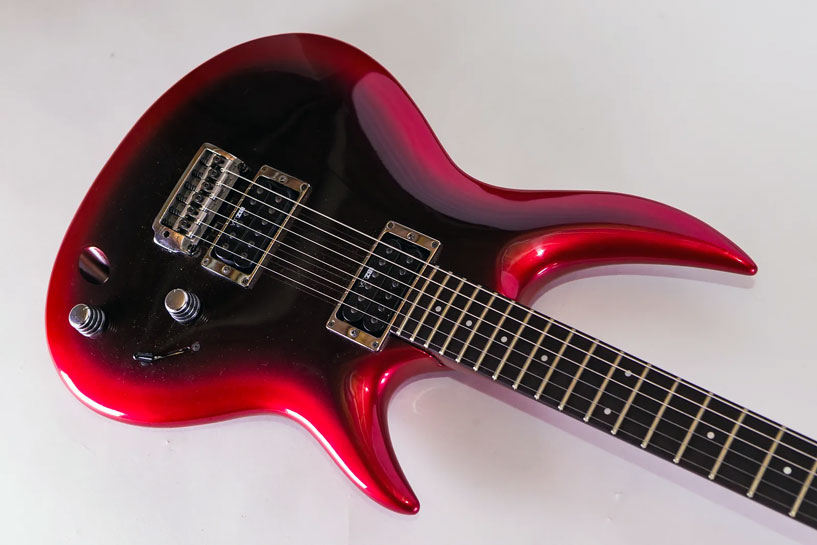
Perhaps a solidbody Maxxas might work? Toward the end of '86, Ibanez had one ready, and someone found a number for Steve's parents on Long Island. Rich made the call. He told them he wanted to get a new guitar to their son. "I said we don't want to impinge on your family," Rich tells me. "But would it be possible if we sent a guitar wrapped as a Christmas present, and you put it under the tree, and it's just from us?"
Rich came off the phone with everyone happy. "We had a solidbody Maxxas," he says, "painted it pink, green, and white snakeskin, wrapped it in some really jolly Christmas stuff, and FedEx'd it over to their house."
The day after Christmas, Steve called Rich. "OK," he said, "you got my attention—what do you want?" Rich told him they really wanted to do a guitar together. Steve relented. "All right," he said, "how about we try something?"
With the long Roth tour finally over in February '87, Steve considered his road-worn gear. The Charvel had taken a battering. Its vibrato mounting collapsed during soundcheck at a prestigious date at Madison Square Garden, and at another gig it went silent. On the last date of the tour, the Performance Playboy got broken onstage, and Steve—with keen assistance from bassist Billy Sheehan—enjoyed completing the deconstruction backstage.

Steve contacted Ibanez and said he was interested in their gadget-of-the-moment, the SDR1000 stereo digital delay. Rich saw this as an opportunity to fly out and take him a couple of SDRs—and talk guitars.
Steve explained he had a bunch of guitars where he loved the body on one, the neck on another, the frets on this one, the pickups on that—but he wasn't one-hundred percent happy with any single guitar he had. Rich suggested Steve make notes on each of the guitars that had something he absolutely loved, send them to Ibanez HQ, and they would build him something that combined all the ideas.
A week later, the guitars showed up. As far as anyone remembers, there was at least a Tom Anderson, a Charvel, and a Performance, and they had Steve's notes stuck to them, as requested: "This neck feels great" and so on. He liked the neck on the Anderson, Rich recalls, and the scoop for the left-hand at the cutaway on the Charvel, while the Performance had the body handle he wanted to incorporate.
"You can't buy the kind of advertising in a magazine that you can get when a star artist is using your gear."
"Once I joined Dave Roth," Steve recalls, "and that Eat 'Em And Smile record came out, and the Crossroads movie came out—well, as you can imagine, all the guitar companies were very eager for me to use their instruments. You can't buy the kind of advertising in a magazine that you can get when a star artist is using your gear. So they were all calling me."
He recalls sending specs and pictures to five or six companies who also offered to make him something, including Yamaha, and also Kramer, who seemed more interested in wining, dining, and rides in the limo. Back came the guitars—eventually. And they had very little to do with what he had asked for.
"Ibanez, however, took just three weeks and gave me a guitar that was exactly what I wanted," he says. "In fact, it was better than what I wanted."
Ibanez had its own reasons to be so quick. Rich Lasner and Bill Reim knew they might be able to launch a Steve Vai signature model at the forthcoming summer NAMM show, just months away. Steve seemed to be exactly the personification of the brand they had in mind. With business still in the doldrums, Ibanez needed a new and exciting guitar sooner rather than later.
Rich took two JEM prototypes to show Steve. He pulled out the first one, and Steve did not play it. Instead, he took it apart.
"Steve said relax, I do this to every guitar I have," Rich recalls. "He explained that he really wanted to know how the guitar worked. He put it back together, and he said: 'You know, this is a damned good guitar.' He said it was really well done. He checked out the second guitar and he liked that, too. So we left one with him, and we took one back to the shop. Those guitars were essentially 90 percent of what the production guitars became. Most of what was missing was cosmetic."

That imminent NAMM show in '87 would mark 30 years since Ibanez's first electric guitars—not that anyone would have noticed at the time. The brand was owned by the Hoshino company of Japan, which began when Matsujirou Hoshino opened a bookshop in Nagoya. He added a musical instruments section in 1908.
Twenty years later, after a tour by the great Spanish classical guitarist Andrés Segovia, Hoshino began importing classical guitars from Salvador Ibáñez in Valencia. When that workshop was destroyed in the Spanish Civil War at the end of the '30s, Hoshino kept the name, making acoustic guitars in Japan. At first these were branded "Ibanez Salvador" and soon simply "Ibanez."
Aside from those and a few other early efforts, Hoshino has never built instruments. The first electrics appeared around 1957, and from 1970 or so, most were made by the Fujigen factory in Matsumoto, which became a valuable partner for Ibanez. Hoshino set up a US operation in 1972, at first known as Elger. This provided not only a sales HQ at the heart of the biggest guitar market in the world, but also invaluable feedback about the kinds of instruments that American guitarists wanted to play.
Copies began in the '60s, and Maurice Summerfield, the original UK distributor for Hoshino's instruments, provided valuable information to the Japanese. He recommended they add to the line a copy of the Gibson Flying V, the old model recently given a low-key revival by Gibson. Summerfield bought a Flying V and sent it off to Japan, and soon Ibanez was making a copy, followed by one of a Gibson double-neck.
By 1976, the brand was offering two dozen different Les Paul–style models, among many other copies, but also it had begun to experiment with original designs, including a few double-cutaway solidbody models, starting in '73, and the angular Iceman, launched in '75.
Gibson registered a headstock trademark in 1975 and warned Ibanez—which had already started to use another style of headstock. Two years later, Gibson filed a complaint in court, claiming infringement of its trademark. Ibanez agreed to stop infringing Gibson's trademarked headstock design—which it had already done. An out-of-court settlement closed Gibson's complaint in February 1978. This was the origin of the now carelessly applied term "lawsuit era."
By the early '80s, Ibanez was struggling to make a mark. Its focus now was entirely on new designs rather than copies, including two George Benson jazz guitars, introduced in 1977, plus a year later the Alembic-influenced Musician and Studio guitars, and some elegant carved-body models in the Artist and Professional series. But none of those could match the impact that a Steve Vai model, now in finished prototype form, might make in the valuable mainstream rock market.

The summer '87 NAMM show took place in Chicago, running from June 27–30, and the Ibanez booth was buzzing with excitement. What were they hiding under that big black shroud watched over by a security guard? At last the moment arrived when all would be revealed. It was the talk of the show, and the booth was packed.
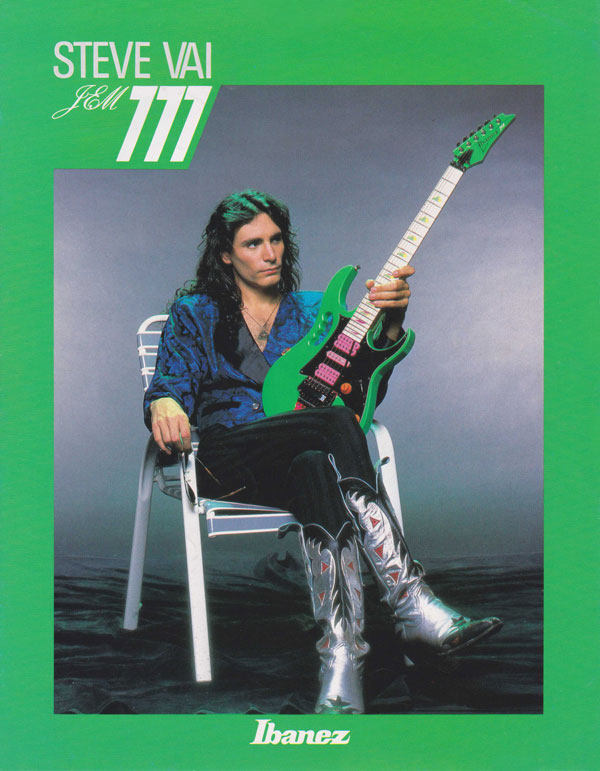
Rich Lasner was beside the big monolith, which was still covered up. "You could see all the guys from Kramer," he says, "who had been pretty much kicking our ass for the last couple of years with Van Halen. They were standing there with their arms folded, wondering what on earth's going on. We dropped the black cloth, and there's a giant poster of Steve Vai playing the JEM. Everybody applauds. I look over at the Kramer guys. Their jaws are on the floor, and then they're walking away. That to me was a moment of, like, Wow! We actually may have done this. You know? We did something here."
The JEM had a unique combination of features, and it looked nothing like any other electric guitar. The body came in one of three striking fluorescent colors, with matching headstock and colorful contrasting pickups and controls. The basswood body itself had an extended Strat shape, with squared sides, pointy horns, and a Monkey Grip handle-hole.
The Monkey Grip name was borrowed from horse riding, where a monkey is a handle clipped to a saddle so the rider can hang on when the going gets tough. Steve used his for stage antics, whirling the guitar around and hanging on to the handle. He also figured it gave the guitar a unique look, although a few '60s Guyatones and Teiscos had featured something similar.
Ibanez's Edge locking vibrato system had Lion's Claw furrows behind the bridge, which added some extra pull-up space. DiMarzio colorful pickups were in humbucker/single-coil/humbucker formation, an early occurrence on a production guitar, and Steve got his favored single-coil in-between settings thanks to Steve Blucher at DiMarzio, who provided the five-way circuit. [Ed: An earlier version of this paragraph stated the JEM's HSH formation was the first in a production guitar. See the comments section below for more detail.]
The maple neck was more or less Ibanez's thin Ultra style, with a little more chunk and a cutaway neck heel. There was a maple fingerboard featuring distinctive-colored Disappearing Pyramid inlays, a 25.5-inch scale, and 24 frets, scalloped from the 21st upward, inspired by Billy Sheehan's Yamaha basses and a guitar Yngwie Malmsteen had showed Steve.
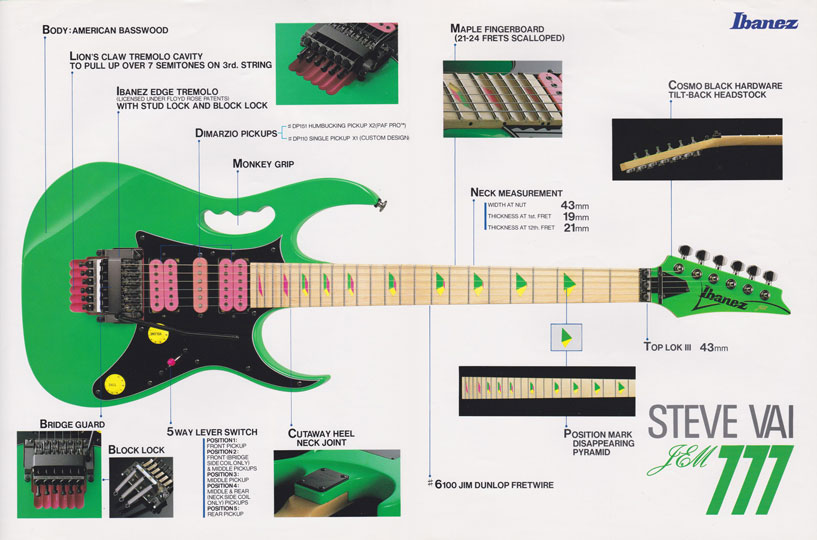

The JEMs debuted in 1987 in three color variations: the limited-run JEM777LG in Loch Ness Green at $1,590, with the regular JEM777, in Desert Sun Yellow or Shocking Pink, at $1,299. They weren't exactly cheap. A Gibson Les Paul Standard listed at a touch over $1,000 in 1987, a Fender American Standard Stratocaster at $650. The JEMs weren't just distinctive; they had an upscale vibe and a price to make you stop and think.
Nonetheless, all 777 of the limited-edition green model sold out quickly. "They were gone immediately," Rich says with a smile. "The JEM was a wild success from the very first day of sale. Amazing, really."
Ibanez had another trick up its sleeve. Also released that summer was the new RG550 model. Perhaps it was a little overlooked, what with all the fuss around Steve Vai and the JEM, but it would turn out to be an even more important guitar in Ibanez history.
The new RG (not be confused with earlier-style RGs) was almost identical to the JEM, minus the wild colors and fancy inlays, the Monkey Grip handle, and the scalloped frets. Steve and the JEM were beacons that drew a great deal of attention to Ibanez, but the various new RG models that followed were lights that would burn brightly and consistently every day.
In the late '80s and into the early '90s, following its introduction of the JEMs and the revised RGs, Ibanez found a fresh confidence, buoyed up by the success of these new designs. And it didn't hurt much when Kramer—the brand that had dominated the '80s—went bust in spectacular fashion around the end of that decade.

Ibanez has issued a number of different JEM models over the years since the introduction of the 777. One of the oddest was the JEM77FP, the FP standing for Floral Pattern finish, a vivid printed cloth bonded to the body. At first, Ibanez planned to make just one guitar like this, special for Steve. Nick Sugimoto at Fujigen R&D had recently helped Fender reissue its paisley-finish Telecasters, which also employed a bonded-material finish, and that proved to be useful experience.
"At the end of the '87 NAMM show, there was Steve on stage with this flower-pattern guitar," Nick remembers. "And, of course, all the distributors saw this—and they wanted this other new JEM guitar, too! So now we had to work out how to make it as a production model. That meant a lot of work, developing glue sprays, sealing coats, and so on. That's why it took eight months from the NAMM show before we could issue that guitar."
There was the JEM-EVO of 2012, a scratch-by-dent-by-ding re-creation of Steve's favorite guitar since about 1993, the JEM he calls Evo. Nick Sugimoto, by now running his own Sugi Guitars workshop in Matsumoto, made the 100-piece limited-edition aged guitar.

A 20th anniversary JEM model in 2007 had a see-through acrylic body with internal LEDs, and the JEM2KDNA—one of Ibanez's special millennium models in 2000—had Steve's DNA incorporated into the fingerboard's vine inlay.
"I went to the hospital and had a lot of blood drawn," he remembers with a grimace. "It's not like there's a tiny drop of my blood on those guitars. There's a lot! I had to eat plenty of bananas after that. A hundred years from now, if they get cloning down, maybe they can take one of these DNA guitars and clone me out of the guitar? And then maybe that guy can get his music on the radio."
Today, there are three levels of JEM in Ibanez's catalogue, starting with the budget white JEMJR and yellow or pink JEMJRSP, made in Indonesia. Moving on, there's the middle-ranking Premium blue floral JEM77P and white JEM7VP, both also Indonesian. And up at the high end, there's the white JEM7V, made in Japan. Reflected in the price points, they come with varying neck and body materials and construction, different pickups, metalwork plating, fret treatment, and so on.
Bill Reim, who today is Hoshino USA's CEO, says: "The JEM design was a real homogenization of a lot of different ideas that people were putting on the table, but mostly it was Steve. He was very definitive. He knew what he liked and he knew what he didn't like."
Steve is happy with the continuing success of the JEMs more than 30 years since the first models were introduced. "The people who are the fans and stuff, and collectors, and people who like a fine type of guitar, they will still buy the JEM," he says. "And I've never wanted to play anything else. Still, to this day, I reach for my JEMs, because nothing else is as comfortable. I like to visit New York now and then, you know? And I like to visit Napa. But there's no place like home."
About the author: Tony Bacon writes about musical instruments, musicians, and music. He is a co-founder of Backbeat UK and Jawbone Press. His books include The Ibanez Electric Guitar Book; Electric Guitars: The Illustrated Encyclopedia; and Squier Electrics. Tony lives in Bristol, England. More info at tonybacon.co.uk.

